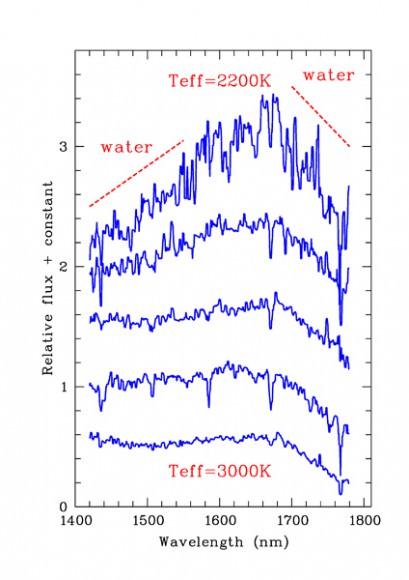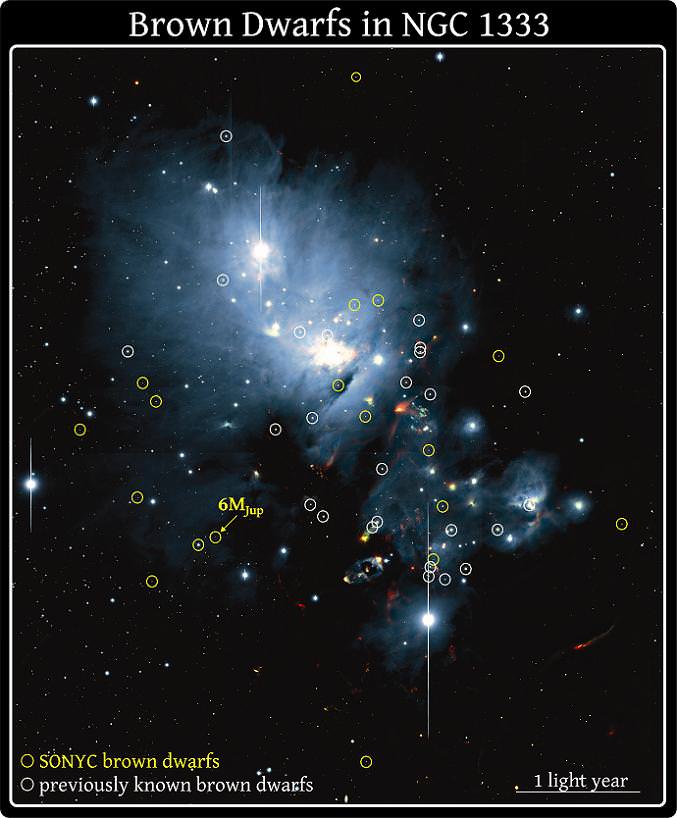[/caption]
Using two of the world’s largest optical-infrared telescopes, the Subaru Telescope in Hawaii and the Very Large Telescope (VLT) in Chile, an international team of astronomers has discovered more than two dozen brown dwarf stars floating around in two galactic clusters. During the Substellar Objects in Nearby Young Clusters (SONYC) survey, these “failed stars” came to their attention by showing up in extremely deep images of the NGC 1333 and rho Ophiuchi star clusters at both optical and infrared wavelengths. To make the findings even more exciting, these stellar curiosities outnumbered the “normal” stars in one cluster!
“Our findings suggest once again that objects not much bigger than Jupiter could form the same way as stars do. In other words, nature appears to have more than one trick up its sleeve for producing planetary mass objects,” says Professor Ray Jayawardhana, Canada Research Chair in Observational Astrophysics at the University of Toronto and leader of the international team. Their discovery will be published in two upcoming papers in the Astrophysical Journal and will be presented this week at a scientific conference in Garching, Germany.

Using spectroscopy, the researchers were able to separate candidate brown dwarfs by their red color. But there’s more to the story than just hues. In this case, it’s the identification of one that’s only about six times more massive than Jupiter. Located in NGC 1333, it is the smallest known free-floating object to date. What does that mean? “Its mass is comparable to those of giant planets, yet it doesn’t circle a star. How it formed is a mystery,” said Aleks Scholz of the Dublin Institute for Advanced Studies in Ireland, lead author of the first paper.
Brown dwarfs are indeed unusual. They walk a fine line between planet and star – and may have once been in stellar orbit, only to be ejected at some point in time. But in this circumstance, all of the brown dwarfs found in this particular cluster have very low mass – only about twenty times that of Jupiter. “Brown dwarfs seem to be more common in NGC 1333 than in other young star clusters. That difference may be hinting at how different environmental conditions affect their formation,” said Koraljka Muzic of the University of Toronto in Canada, lead author of the second paper.
“We could not have made these exciting discoveries if not for the remarkable capabilities of Subaru and the VLT. Instruments that can image large patches of the sky and take hundreds of spectra at once are key to our success,” said Motohide Tamura of the National Astronomical Observatory of Japan.
Free-range brown dwarfs? I’ll take mine over easy…
Original Story Source: Subaru Telescope News.


Obvious prediction: there are more brown dwarfs than all other stellar types combined.
Yep. The lower the temp, the more numerous the star. M-class main sequence stars, far outnumber G class main sequence stars, which outnumber A-class stars, etc. This is partly because higher mass stars burn through their hydrogen supplies faster, while less massive stars slow-burn for billions of years longer.
I’d bet that there are 3 to 5 times the number of brown dwarfs than stars, maybe more. Because they don’t fuse (or fuse for short periods), they should last for a very, very long time, meaning there should be a wide ranges of ages. It’s possible that some of the oldest objects out there are brown dwarfs.
Some form independently, some were part of star systems, but get ejected.
This is not quite true at these low masses! The mass function (which would be a function describing how many stars are there per mas bin) has a positive slope down to approximately 0.1 solar masses (this number varies from region to region), so down to these masses your statement is correct- there are indeed more M-dwarfs than let’s say G-dwarfs. Below, however, the mass function has a turnover and the number of objects starts to decrease, so at the end brown dwarfs not as common as you might think!
How exactly can a 6MJ object be a Brown Dwarf? That’s way too small for any fusion to have occurred in the interior isn’t it? (I thought the smallest possible BD was about 13 MJ)? Shouldn’t that just be a free-floating gas giant instead?
The definitions begin to blur at these levels. Theories of formation may come into play. I’d call it a sub-brown dwarf, or a Planemo.
It appears that astronomers who categorize these objects put as much weight (Ha Ha) into HOW they formed as they do in the mass of the object. Free floating large planets then would look more like an undersized star. I think all these overlapping definitions just get us into more trouble arguing over semantics. Call things what they ARE, not how they came to be. Besides how can we really know how things came to be? We only see them as they appear now.
In biology they distinguish populations by the pathways they take (phylogenies). It serves the area well.
Of course there is a heritable component, but the idea of nested sets of characteristics that occurs for evolving objects on different paths is general.
So in principle possible, maybe even valuable.* In practice? We’ll see.
————–
Evolutionary paths have been tried with the main sequence/HR-diagram, I think. That seems to work.
Here are links to the two relevant papers:
Substellar Objects in Nearby Young Clusters (SONYC) IV: A census of very low mass objects in NGC1333;
Substellar Objects in Nearby Young Clusters (SONYC) V: New brown dwarfs in rho Ophiuchi.
P.S. Yo Tammy, at the second paragraph, it should be “published in”, not “in published”, in the fifth line: “Their discovery will be in published two upcoming papers…”
fixed. 😀
NGC 1333 is located about 1000 light-years away in Perseus while the Rho Ophiuchi star cluster is estimated to be about 500 light years away – both of which are relatively close by. Are these Brown Dwarfs near the limit(s) that our best telescopes can observe? I wonder what that says about the total number of Brown Dwarfs in our galaxy?
We now know that the smaller, more “primitive” forms of life (bacteria, viruses) greatly outnumber (and even outweigh) the “higher forms”. The brown dwarf observation might be indicating the smaller, more “primitive” forms of stars might indeed greatly outnumber the “higher forms” that we see and admire. No scientific basis to this parallel, of course, but it’s fun to think of it!
There IS a scientific basis, as this article points toward. Since there are MANY more brown dwarfs than ‘normal stars’ the question might then be, could life evolve around them? The odds are good…
I bet there are clouds of brown dwarfs in the dense environments similar to the pillars of creation.
Sort of sub-luminous globular clusters. It’s east to imagine mergers of them having a prominent role in stellar formation. The better our methods of detecting them the more we find.
They are a dark matter. (sorry couldn’t resist)